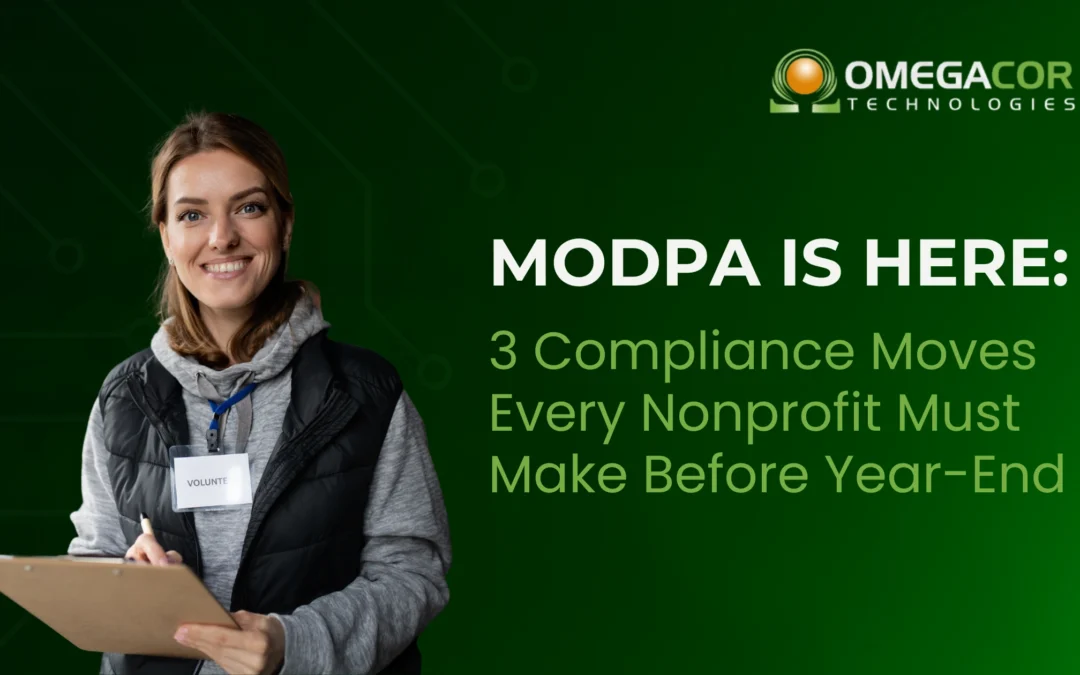You didn’t start your nonprofit to spend nights reading legislation. You started it because your community needed you, because families needed food, neighbors needed shelter, or students needed opportunities.
But as of this year, the Maryland Online Data Privacy Act (MODPA) is here, and it has changed the way all organizations, nonprofits included, must handle personal data.
That may feel daunting, especially when your staff is already wearing too many hats. You’re not alone. Nonprofits across Maryland are asking the same questions right now: Are we ready? What will this mean for our donors? How do we keep up without losing focus on our mission?
The encouraging news is that you still have time to put structure around MODPA before year-end. With a few intentional steps, you can protect the trust of the people who believe in you and free up your staff to keep doing the work that matters most.
Why Year-End Is the Right Moment
We know year-end is overwhelming: fundraising pushes, holiday programs, budget reviews, closing the books. It’s one of the busiest times in the nonprofit calendar.
But it’s also a natural moment to pause, reflect, and make strategic adjustments. By addressing MODPA now, you’re not only staying compliant, you’re showing donors, volunteers, and partners that you value their trust deeply.
And that trust is everything. In fact, cybersecurity and compliance are consistently ranked among the top concerns for nonprofit leaders (RSM US). Yet many nonprofits admit they aren’t fully prepared, especially when it comes to responding quickly to new regulations.
Move 1: Take Stock of Your Tech, Without the Overwhelm
Most nonprofits we talk to don’t have one neat, perfect system. They have a mix: a donor database here, spreadsheets there, maybe a volunteer app, a grant tracker, and a payroll tool, each storing pieces of personal data.
That’s normal. But under MODPA, it can create risk if those pieces don’t connect.
Here’s a simple way to begin:
- Write down the systems where personal data lives.
- Circle the ones that overlap or don’t talk to each other.
- Ask your vendors if their tools are MODPA-compliant (many now include features like consent tracking and audit logs).
- If you spot gaps, make a short list of priorities for 2026.
This doesn’t have to be a complete overhaul. Even one or two changes can lighten the load for your staff and make compliance easier.
Schedule Your Nonprofit IT Readiness Consultation. Together we’ll map what you have, identify what matters most, and create a calm step-by-step plan your staff can trust.
Move 2: Build a Gentle, Clear Process for Data Requests
MODPA gives people the right to access, correct, or delete their data. For donors, volunteers, or clients, this is about dignity and respect. For you, it’s about being ready with clarity instead of panic.
Questions to guide you:
- Could you find and share all the information you hold on a donor within 30 days?
- Do you have a record of how each person gave consent to be contacted?
- Would your staff know who to turn to if someone asked about their data?
If not, that’s okay. Many nonprofits are starting from scratch here. The important thing is to begin:
- Clean up your records. Remove duplicates and old data.
- Write down your process. Even a one-page checklist is powerful.
- Look for automation. Modern CRMs often make compliance much simpler.
- Train your team. A five-minute staff huddle can prevent confusion later.
Perfection isn’t the goal. Clarity, transparency, and processes that reflect the respect you already show your community are.
Move 3: Strengthen Your Foundation for the Long Haul
Policies like MODPA are part of a larger trend. More regulations will come. More expectations will be placed on nonprofits. The question isn’t “how do we get through this?” It’s “how do we build a foundation that keeps us steady no matter what comes next?”
That foundation looks like:
- Staff who feel supported instead of overwhelmed.
- Leaders who see compliance not as a burden, but as a way to deepen credibility.
- Technology that feels like an ally, not an obstacle.
Reports show that nonprofits embracing digital transformation are better positioned to increase donor engagement and adapt to rising demands (Sage Intact). That’s resilience in action.
Two Possible Stories
Imagine two nonprofits:
- One waits. When a donor makes a data request, panic sets in. Staff dig through spreadsheets, frustration grows, and confidence slips. Donors hesitate. Funders worry. The mission suffers.
- Another prepares now. When a request comes, they respond calmly. The donor feels respected. The staff feels capable. Funders see integrity. The mission grows stronger.
Which story will yours be?
Where to Begin
Catching up on MODPA doesn’t have to be overwhelming. Take one step, then the next. Each small move strengthens your nonprofit and protects your mission.
Start with our Donor Data Privacy Compliance Checklist. It’s a quick, actionable way to identify blind spots and safeguard your donors’ information.
And if you’d like a steady hand to guide you:
Schedule Your Nonprofit IT Readiness Consultation today.
A Final Word of Encouragement
Your nonprofit exists to serve, to build, and to heal. MODPA may feel like one more hurdle in a year already full of challenges, but it doesn’t have to steal focus from your mission. With the right preparation, it can actually give you more freedom, more trust, and more confidence to do what you do best: care for your community.
At OmegaCor, we stand for IT that aligns your mission and believes in what you’re building. We’re here to make sure your systems are as strong as your heart for service.

